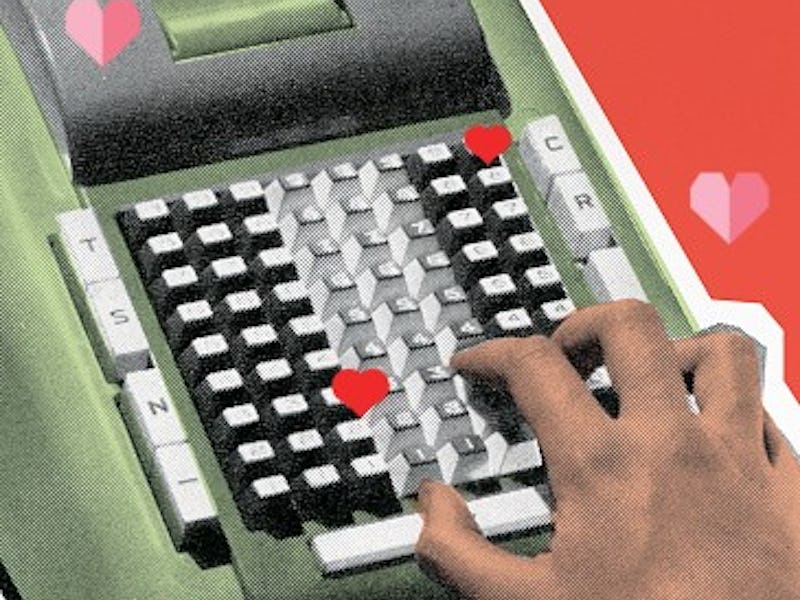The love calculator: How many dates does it take to find the "one"?
Use math to hack your love life.

Online dating, from Tinder to Farmers Only, means singles exist within a larger dating pool than ever before. With oodles of potential partners, knowing when to get off the dating treadmill and choose a companion is harder than ever. A potential solution? Crunch the numbers.
At least that’s the approach of Dominik Czernia, a Ph.D. candidate in condensed particle physics. Frustrated by his own winding path towards love, the researcher decided to apply mathematical theories to dating. He built a dating theory calculator for the company Omni Calculator, a website that aims to calculate everything from the time it takes to quit smoking to how much alcohol to serve at a wedding.
Plugin your dating habits, expectations, and goals, and the dating calculator spits out a customized timeline and probability for when you are likely to meet the “one.” You can try the calculator, here.
Sure, the method isn’t perfect at predicting the often messy path to commitment, and the idea that you can reduce the complexity of finding love down to a formula seems unlikely. However, it is based on some rigorously tested principles — and it could be a useful tool, allowing people to up their chance of finding a mate. Maybe (just maybe) a calculator could make love feel a little bit less like a “losing game.”
“Math cannot take into account every factor,” Czernia tells Inverse. “Math cannot take into account feelings. It should only provide advice — what you should do, not what you have to do.”
Putting a number on love
Czernia’s new dating calculator, completed on Monday, works off an idea called the "optimal stopping" theory. This rule is typically used to determine when to take a certain action to maximize payoff and minimize future costs. In dating, it helps solve the classic dating dilemma of whether to love the one you’re with or keep hunting for the next best thing.
Other mathematicians have also applied the theory to dating. Hannah Fry outlined the method in her popular Ted Talk, “The Mathematics of Love.” Czernia is the first to create a calculator based on this line of thinking.
According to Czernia, in a dating context, the optimal stopping theory advises rejecting the first 37 percent of potential matches. Maybe that sounds harsh, but that's math.
Theoretically, if you have 10 suitors lined up (who does, but this is a theory!), you reject the first four as committed partners, no matter how perfect, dreamy, or compatible they seem. After the initial four candidates are knocked out, you then choose the next person in the line up who seems better than anyone you met previously. This is your ideal partner. They aren’t necessarily your “soulmate,” but according to math, they could be your best shot. Czernia says this process boosts your chances of meeting the ideal partner by 30 percent.
But the danger lies in estimating that 37 percent. It's near impossible to predict how many potential partners you'll encounter over a lifetime. And what happens if your perfect match shows up early on? In that nightmare scenario, you reject your ideal partner and end up alone. Another risk? Your first four dating experiences are awful, leaving you with low standards for future partners. Future candidates might seem fantastic by comparison, even if they’re actually average or incompatible. In this second case, you end up in a sub-optimal relationship.
An example calculation.
Of course, the calculator hasn’t been tested for accuracy — but that's not really the point. It’s about upping probability, not a proving 100 percent guaranteed timeline of meeting the right person, Czernia says. How these predictions play out in the midst of IRL complications like partner rejection, professional obligations, or even cheating, isn’t clear.
Love isn’t strictly a numbers game, Czernia says. “It’s not, ‘I should reject this many people... No that is not what love is about." But he does think that getting into a relationship with the first partner you meet "isn't great."
The aim of the calculator is to make people aware of the risk of taking the plunge too early, he explains.
“I hope people will use this calculator to estimate how many dates they should go on and to find what they should aim for, find out what they expect from a partner, and the things they care about most in other people.”
The search
Ultimately, Czernia hopes his calculator will encourage people to stay in the dating game a little bit longer than usual. Research shows people often give up the search too soon when faced with problems where they encounter options sequentially, like buying a house or even stopping for gas. Dating experiences — and knowledge that you gain from those about what you like and don't — equip people to better select a mate, rather than settle early without that clarity.
“I think that people are scared that they will be alone or single for the rest of their lives,” Czernia explains.
They prefer to stop earlier when searching for love to avoid this fate. But don’t give up, Czernia says. One day, with the aid of the calculator (he hopes) you'll find the "one." Czernia dated 15 people before he found "the one" — so maybe he knows what he's talking about.